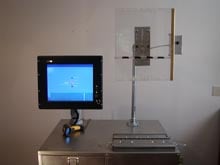Recently Voler Systems designed and built production test equipment to test a disposable cardiac ablation catheter and calibrate thermocouples embedded in it. Previously Voler Systems performed accuracy calculations for the system including the catheter, the console it plugs into, and the calibration of the catheter. Following this accuracy calculation, our client, a leading medical device corporation, requested that we develop a test and calibration system designed to achieve the precise accuracy required with high reliability and repeatability. The tester that Voler built achieved a calibration repeatability of 0.03 degrees C which ensured that the total temperature measurement would meet specifications. This is highly precise for thermocouple measurements and required careful design and testing.
Calibration Bath for Single-Use Sensors
We designed the tester to check the function of the catheter and to calibrate the thermocouples. The only way of being confident in a sensor is to have it calibrated and only then can we be sure that the reading it gives is meaningful. The necessity of calibration applies especially to those medical devices that can affect a patient’s health or treatment. Faulty medical devices can be the cause of false diagnoses or worse. If the thermocouple temperature sensor were to fail the catheter could cause severe injury to the patient.
The tester design was done on an accelerated schedule with no room for schedule slip. We had two vendors that caused problems for us. One was the vendor that provided the cart that holds all the equipment, and this stainless steel cart had to be modified from the standard design. A few days before the cart was supposed to be delivered, the vendor told us that they were unable to deliver anything. In one week we were able to locate several other vendors, select one, get drawings made and have the cart fabricated from scratch. We met the schedule. Another vendor of specially fabricated Teflon tubes had real problems in creating the tubes; due to our diligent project management they managed to produce something that we could use in time
Software Control

Simple Operator Control
Voler designed a custom circuit to simulate the console the catheter plugs into. This circuit is critical, because it must match the performance of the console or the calibration is not valid. When the final console is available, Voler will perform an analysis to assure compatibility. Besides the custom circuit, the tester includes a temperature bath, barcode reader, UPS, and a significant amount of software. The system was designed to minimize the need for user intervention and for probe-specific knowledge during testing and calibration. An operator simply presses a button and they get a green light or a red light. Making everything run correctly behind the user interface software is quite complex, particularly with a calibration. It must give accurate results in all conditions. Our system allows the calibration parameters to be stored in the catheter without user intervention and risk of confusion. The software performs an extensive series of tests but presents a user interface that is clean and straightforward.
Traceability and Validation

Calibration Bath
The device must also meet the government regulations regarding device traceability and validation. In calibration a traceable measurement is one where the start and end of a calibration chain can be followed. The test system provides end to end traceable calibrations. This has been achieved by storing sensor-specific information, such as calibration gain, offset, lot ID and model information. All this information and the results of calibration are stored in a non-volatile memory chip in the handle of the catheter. The EEPROM stores critical dates such as manufactured, tested, calibrated and first use dates. Additionally it stores code version and a checksum that verifies which data was read back correctly.
Voler participated in the software validation testing with the client. Software validation assures the tester meets its requirements, is effective, and assures a very low risk of bugs. This is achieved by methodical and documented procedures, a code walk through, and a painstakingly detailed validation test plan.
Tester Throughput Rate
One important factor in the tester design was throughput rate. The limiting factor for this system is the time it takes for the catheter to reach temperature after it is placed in the bath. And, there is not much you can do about that but wait for the temperature to change. We did all we could to make it work as fast as possible, for example by having multiple catheters in the well. As delivered, it can handle two probes at once in the bath. We included the option to add another bath, which will cut the time almost in half.
Summary
The data shows that calibrations are both accurate and precise. The assurance of consistent and reliable sensor performance is backed by statistical data. We meet the accuracy requirements for the disposable. The tester provides the device with all the sensor-specific information to meet the government regulations regarding device traceability and validation. The tester has been shown to be accurate and effective in testing and calibrating the single-use catheter. And it was delivered on time.